|
2
December 2001
Punta Leona, Southern Costa Rica
09*42.58N; 084*89.78W
Here
in Costa Rica there is so abrupt and striking a difference between
the rainy season and the dry season that we could have been in two
entirely different places this past month and a half. For three
long weeks we were chained to the dock in Golfito, forced to wait
for the delivery of things we’d had shipped in, then delayed
further by a sequence of computer problems. For those three long
weeks the rainy season worked itself up to a frenzied finale. During
the day showers cycled on and off, and, by late afternoon when all
beleaguered life forms would assemble for the communal 2-for-1 happy
hour in the marina restaurant, the heavens would really open up
with a full-fledged downpour, thrumming on the corrugated roof,
blanking out from view all the anchored boats, and turning the water
a muddy brown. 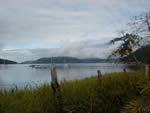 Don’t
get us wrong, Banana Bay was a nice place to be stuck if you had
to be stuck, and we made many new friendships (unfortunately, mostly
with people going the other way) and watched a lot of CNN on cable
TV, but as the days ticked off, the Two Captains became obsessed
with getting under way. Don’t
get us wrong, Banana Bay was a nice place to be stuck if you had
to be stuck, and we made many new friendships (unfortunately, mostly
with people going the other way) and watched a lot of CNN on cable
TV, but as the days ticked off, the Two Captains became obsessed
with getting under way.
The very day
we left the dock was the first day of no rain. It was still overcast
and muggy, but as Tackless II eased out the channel into the Golfo
Dulce, there was enough of a breeze to set all the lines and halyards
not properly secured aflutter and enough of a chop to produce a
chorus of bangs and crashes from below. Although it kept us scurrying,
to our ears it was just the theme song of our condo finding its
sea legs once again. We survived the two-hour crossing to Puerto
Jimenez where the captains and their craft breathed a huge sigh
of relief!
Two mornings
later, shipshape once again, we raised anchor at 0500 and sailed
…er …motor-sailed…out of the Golfo Dulce to a crystal
clear sky and one of the most fabulous sunrises we’ve ever
seen. The 57nm trip took us around Cabo Matapelo (where we’d
hiked with monkeys and macaws back in August) and northwest along
the Osa Peninsula’s Pacific Coast. We had a dozen hits on the
fishing line, the second of which was a huge dorado (mahi mahi)
that leapt clear of the water repeatedly before and after breaking
our line and making off with our lure. Boy, they are spectacular
to see! But, despite all that adrenaline and we only boated one
fish, which turned out to be another of the “feed the cat”
variety of skipjack. Still, it felt good to be out in the sea, sun
and breeze.
We spent two
nights at Drake’s Bay on the north end of Osa where our old
friends from the Caribbean Mac and Sam of Sandi Lee caught up with
us. Drake’s Bay is rimmed by a series of wilderness camps,
reached by boat only. There are no roads. We checked a few out by
foot, and there’s no doubt any of the places would be great
for “getting away from it all. Although known for some good
diving, conditions were green and murky from all the rain so we
passed.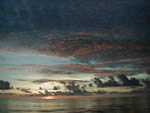
From Drake’s
Bay, both boats took off on an overnight passage of 84 miles to
the Gulf of Nicoya. Traveling with another boat you know is comforting,
especially when caught in a cloudburst. You figure out quickly just
how far away they can be and still see their nav lights. This may
have been a false sense of assurance as most Costa Rican fishing
boats don’t show proper running lights, making it anyone’s
guess which way they are going let alone that they are there at
all! We got so confused by the movements of one boat that we all
three passed within yards of one another!
Our anchorage
at Punta Leona had eight boats in it when we dropped the hook the
next morning, a rare assemblage on this Pacific Coast. All of them
were cruisers heading south from California, and a great and social
group they were, too, welcoming in the two odd ducks flying against
the stream. 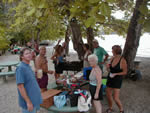 Punta
Leona is on the southern shore of the Gulf of Nicoya. The area is
just south of the dividing line between the wet tropical forests
of the south and the drier climate of the north. The land embracing
the anchorage (and as far as one could see) belongs to the Punta
Leona Beach Club and Resort, a relatively middle-aged facility nestled
in a pocket of primary rainforest. The club facilities -- including
two beaches, several pools, a putt-putt golf course, playground,
bars, night club, several restaurants and a half dozen hiking trails
-- are immaculately maintained for the use of their members who
flock in from San Jose for R&R mostly on the weekends. We lost
count, as we hiked around, of the “clumps” of accommodations,
scattered through the woods and hills, not one cluster bearing any
architectural similarity to the others! New condos and houses were
under construction in several remote spots while the oldest “villas”,
close in on the club grounds, were actually dressed up mobile homes!
So far the cruisers anchored in the bay have been welcome to use
the facilities, even to participating in the free daily guided nature
tours, in exchange for the purchase of a beer or dinner or two!
As you might guess this makes it a pretty popular spot for cruisers
to linger, especially ones meeting holiday visitors. Punta
Leona is on the southern shore of the Gulf of Nicoya. The area is
just south of the dividing line between the wet tropical forests
of the south and the drier climate of the north. The land embracing
the anchorage (and as far as one could see) belongs to the Punta
Leona Beach Club and Resort, a relatively middle-aged facility nestled
in a pocket of primary rainforest. The club facilities -- including
two beaches, several pools, a putt-putt golf course, playground,
bars, night club, several restaurants and a half dozen hiking trails
-- are immaculately maintained for the use of their members who
flock in from San Jose for R&R mostly on the weekends. We lost
count, as we hiked around, of the “clumps” of accommodations,
scattered through the woods and hills, not one cluster bearing any
architectural similarity to the others! New condos and houses were
under construction in several remote spots while the oldest “villas”,
close in on the club grounds, were actually dressed up mobile homes!
So far the cruisers anchored in the bay have been welcome to use
the facilities, even to participating in the free daily guided nature
tours, in exchange for the purchase of a beer or dinner or two!
As you might guess this makes it a pretty popular spot for cruisers
to linger, especially ones meeting holiday visitors.
The 2Cs, somewhat
suckered by this first burst of good weather, conceived the idea
of daughter Tiffany and her boyfriend Derek coming to visit for
Thanksgiving.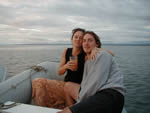 They jumped on the idea, and, despite the short notice, despite
the crash of the American Airlines jetliner in NYC, got themselves
to Punta Leona (with a little help from the folks) just in the nick
of time to experience the experimental cooking of a 6 kilo Butterball
on the BBQ grill. (Our oven was out and T&D had the crucial
part in their luggage!) Cut in two halves to fit, the bird cooked
very fast! So fast, in fact, that Thanksgiving dinner was moved
up to mid-afternoon, barely four hours after we got them aboard!
It was a great meal, nonetheless, with all the expected trimmings,
and for sure this year we all felt most aware of the things we had
to feel thankful for, not the least of which was being together.
They jumped on the idea, and, despite the short notice, despite
the crash of the American Airlines jetliner in NYC, got themselves
to Punta Leona (with a little help from the folks) just in the nick
of time to experience the experimental cooking of a 6 kilo Butterball
on the BBQ grill. (Our oven was out and T&D had the crucial
part in their luggage!) Cut in two halves to fit, the bird cooked
very fast! So fast, in fact, that Thanksgiving dinner was moved
up to mid-afternoon, barely four hours after we got them aboard!
It was a great meal, nonetheless, with all the expected trimmings,
and for sure this year we all felt most aware of the things we had
to feel thankful for, not the least of which was being together.
The weather,
of course, chose the day after Thanksgiving to revert to the rainy
season. Undaunted, our crew bustled ashore in sneakers to check
out pretty much every hiking trail Punta Leona had to offer, one
after the other. After all, what’s a rainforest without a little
rain?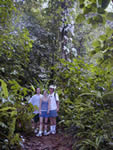 The greenery is lush and primeval, with gnarled tree trunks, huge
roots, tangled vines and scattered flowers. Although we were never
early enough for real good birding, we managed to see at least some
wildlife courting butterflies, endless columns of industrious leaf-cutter
ants, toucans, a dozing python, and a pack of thieving coatis. The
coati is an elongated relative of the raccoon with much the same
gastronomic tastes. We watched one pair work a huge group beach
picnic, walking on their hind legs like fat dwarfs while crooning
in birdlike tones!
The greenery is lush and primeval, with gnarled tree trunks, huge
roots, tangled vines and scattered flowers. Although we were never
early enough for real good birding, we managed to see at least some
wildlife courting butterflies, endless columns of industrious leaf-cutter
ants, toucans, a dozing python, and a pack of thieving coatis. The
coati is an elongated relative of the raccoon with much the same
gastronomic tastes. We watched one pair work a huge group beach
picnic, walking on their hind legs like fat dwarfs while crooning
in birdlike tones!
Neither Tiffany
nor Derek are natural sailors, and from their point of view life
at Punta Leona seemed pretty good. However, the 2Cs had now been
at Punta Leona for nearly two weeks, and we were starting to feel
as tied down as we had in Golfito! Clearly it was time to get the
anchor up and give Derek a more proper taste of life aboard a cruising
boat. 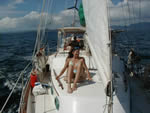 Besides,
the sun was making a valiant try! So we motored across the Gulf
of Nicoya to a small cluster of islands known as the Tortugas, where
there were some pretty beaches and blue water….and a bunch
of day tour boats. These all cleared out by evening and we were
left alone to enjoy our first noodle hour in the Pacific with a
flaming sunset. The next day, Don and the kids tried their best
to catch us a fish, but our Osa luck hung with us despite new lures.
We just couldn’t get anything aboard, so… we cheated…we
bought a dorado from a fisherman! Besides,
the sun was making a valiant try! So we motored across the Gulf
of Nicoya to a small cluster of islands known as the Tortugas, where
there were some pretty beaches and blue water….and a bunch
of day tour boats. These all cleared out by evening and we were
left alone to enjoy our first noodle hour in the Pacific with a
flaming sunset. The next day, Don and the kids tried their best
to catch us a fish, but our Osa luck hung with us despite new lures.
We just couldn’t get anything aboard, so… we cheated…we
bought a dorado from a fisherman!
On Tuesday,
we motored west to Bahia Ballena, a wide south-facing bay on Peninsula
Nicoya. Several rivers feed into the bay and the rain clouds back
in the hills had sent down such a flood of mud and silt that the
bay was as brown and earthy as a mud puddle! However it was flat
calm (anchorages in this part of the world are often quite rolly!)
and there were howler monkeys in the hills, plus there was an actual
pier to which we could tie the dinghy (rather than our usual dragging
it up the beach.) We took to the place immediately. Ashore, we strolled
around the spread-out community of Tambor, (pretty quiet given the
time of year and the drought of tourists), signed up for a trail
ride the next day, and enjoyed a wonderful meal of ceviche and snapper
at the Bahia Ballena Yacht Club (what yachts?)
We were ashore
for our trail ride on time at 0800. Doris, of the Swiss restaurant
Perle was the coordinator. Knowing how Tico time works, she’d
called for the horses to show up at 0730, and in fact they arrived
in a head-to-tail line up promptly at 0830. Not bad. As in the Galapagos,
the horses were quite small, but the tack was better, i.e. real
saddles. Tiffany is quite the animal rights champion and she was
quite worried that at $5/pp/hr the horses might not be well cared
for. We were all relieved to see that the horses were healthy, in
good shape and relatively willing to carry these four tall gringos
around for the day. Doris had her own horse and came along to assist
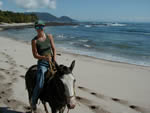 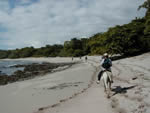 10-year-old
Lavar, evidently playing a little hooky from school, as our guides
for the day. Lavar, like his father, who apparently had other things
to do, was clearly born in the saddle, and he took his role as “the
man” very seriously, climbing down repeatedly to rescue hats
plucked from our heads by passing bushes, opening gates, taking
care of the horses at rest stops. At about 3 ½’ tall,
Lavar made his horse look big! We rode out along the coastline,
enjoying spectacular beach and rock views, a rest break with a large
family of howler monkeys overhead (making Derek’s day, but
impossible to photograph) and, for a finale, a waterfall making
a 40’ drop to the ocean. 10-year-old
Lavar, evidently playing a little hooky from school, as our guides
for the day. Lavar, like his father, who apparently had other things
to do, was clearly born in the saddle, and he took his role as “the
man” very seriously, climbing down repeatedly to rescue hats
plucked from our heads by passing bushes, opening gates, taking
care of the horses at rest stops. At about 3 ½’ tall,
Lavar made his horse look big! We rode out along the coastline,
enjoying spectacular beach and rock views, a rest break with a large
family of howler monkeys overhead (making Derek’s day, but
impossible to photograph) and, for a finale, a waterfall making
a 40’ drop to the ocean.
.
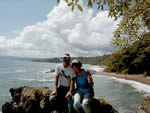 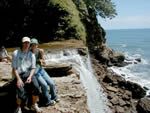
It was a great
day, and yes, after five hours, we could barely walk! So, we sailed
back to Punta Leona, finally catching our own dorado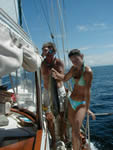 on the way, and the next day rented a nice upholstered Suzuki Gran
Vitara and went land touring.
on the way, and the next day rented a nice upholstered Suzuki Gran
Vitara and went land touring.
Our first outing
took us south to Quepos, passing out of the cattle ranching area
around Punta Leona into acres and acres of palm oil groves. From
sugar cane to bananas to hillside corn crops (not to mention corn
and soybeans in the Midwest!) we’ve seen a lot of different
kinds of agriculture in our travels. These oil palms are handsome
trees, planted in orderly avenues, extending for miles and miles.
The trees grow to about 50 feet tall with thicker trunks than coconut
palms and much bushier crowns. Each palm produce clusters of 70-90
“nuts” about the size and color of red plums, which are
taken by great wagon loads to the processor where they are ground
up and boiled to produce oil used in cosmetics and baked goods.
Palm oil is the crop much of Central America has turned to to replace
bananas, but the paranoia over cholesterol may crimp the style of
this export, too. A palm oil tree produces for about 60 years. It
is then given an injection to kill the tree. Meanwhile the next
generation is already on its way up in the rows between the oldsters.
Made for an interesting landscape.
On a gamble
we took the barely-marked turn for “The Rainmaker”, a
private park highly touted in the Lonely Planet Guide for its river
canyon boardwalk and rainforest canopy bridges, but usually only
opened for organized tours. Our gamble paid off. Although there
were no tours there, and therefor no guides, we were welcomed in
for half price and put in the care of Carlos, a park worker who’d
grown up there. Carlos gave us a great tour, and although I’m
quite sure my Spanish wasn’t quite up to all the detailed medical
applications of this plant or that, we got the gist. The river and
the forest floor was beautiful, with cascading waterfalls here and
there, reminiscent of Cocos, but the true highlight were the suspension
bridges constructed from treetop to treetop across the gorge.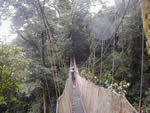
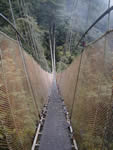 Wow!
Of course, it did start to rain while we were up on the bridges, which
at first actually made it even more mystical. Then, just as we left
the bridges, the rain notched up to a downpour! We were very wet
campers when we left, but we added poison arrow frogs, more ants,
a sloth and a fer de lance snake to our animal roster. Wow!
Of course, it did start to rain while we were up on the bridges, which
at first actually made it even more mystical. Then, just as we left
the bridges, the rain notched up to a downpour! We were very wet
campers when we left, but we added poison arrow frogs, more ants,
a sloth and a fer de lance snake to our animal roster.
The next day,
we packed our bags, locked up TII, and drove to north to Monteverde,
one of Costa Rica’s most famous tourist destinations. Monteverde
was founded by American Quakers from Alabama in 1951.. Upon arrival
they bought 1500 hundred hectares in this mountaintop region and
set up the dairy farming and cheese production community that defines
the area today. What attracts tourists to this area are the cloud
forest reserves, which are a haven for much of the special animal
and bird life of Costa Rica. In recent years many elaborate tourist
projects have sprung up to exploit that interest. Monteverde is
the birthplace of the “canopy tour,” essentially an amusement
park ride disguised as an ecological experience, and there are several
of these available in the area, plus a “Skywalk” tour
somewhat like “Rainmaker”, a butterfly farm, a serpent
farm, as well as old fashioned hiking.
The ambivalence
of the locals to this development is evident in the condition of
the roads to get there. Notoriously bad, they were worse than we’d
imagined, and we were there in absolutely perfect weather. Yes,
finally the weather was on our side, with crisp clear skies and
not a drop of humidity in sight! From the Interamericana Highway
it was thirty-three kilometers of dirt, rock and potholes that took
us, in our four-wheel-drive, two hours and forty minutes to climb!
I have to admit
up front, that the Monteverde we found was NOTHING like what I’d
imagined. When I picture a “cloudforest”, I picture something
like Saba’s misty mountaintop, with moisture dripping from
dense primeval vegetation (see Logbook #1), which, to be fair, might
be how it can be in normal weather conditions. What we found were
steep hillsides of golden grass, dotted with cows and scattered
clumps of trees, and spectacular vistas to the north and south of
mountain ridges and to the west of the glittering Gulf of Nicoya.
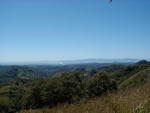 It
was so clear that I believe, if we’d really tried, we could
have seen TII at anchor! It
was so clear that I believe, if we’d really tried, we could
have seen TII at anchor!
Almost there,
we fell in behind the bus from San Jose, throwing up a choking cloud
of dust. This proved serendipitous as it forced up to turn off the
road where we fell into the hands of Eduardo. Eduardo runs one of
those tourist information places you are sure is going to hoodwink
you into their sponsors only, but it turned out to be a stroke of
luck for us as we had only 24 hours to spend. Eduardo had our schedule
whipped into shape within ten minutes. We had a hotel at which to
drop off our stuff and tickets for the Monteverde Canopy tour in
less than an hour! Eduardo did well by us. The Sunset Hotel was
clean, charming and reasonable with an awesome and it was on the
way to the Canopy Tour, which, given the condition of the roads
which if anything got worse! was an important consideration.
We got to the
Tour on time, found ourselves the only ones there for the 1230 “run”,
and put ourselves into the hands of our three young guides. 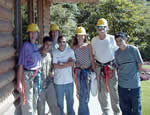 Now,
earlier I called the “canopy tour” an amusement park ride,
which it is, but you should know it is an amusement park ride the
two captains had been looking forward to for nine months since our
taste of it back in Panama. Here’s how it works: you are fitted
into a butt harness replete with pulley, given a hard hat and a
pair of gloves. You follow a short path, climb to platform in a
tree, where your guide hooks your pulley onto a cable. Then, pick
up your feet and …wheeeeeeee…you whiz through the air
across and through the treetops to the next platform. Don’t
kid yourself like the brochures do that there’s any time or
attention to actually “study” nature. Hah! Just catch
your breath and go again! Now,
earlier I called the “canopy tour” an amusement park ride,
which it is, but you should know it is an amusement park ride the
two captains had been looking forward to for nine months since our
taste of it back in Panama. Here’s how it works: you are fitted
into a butt harness replete with pulley, given a hard hat and a
pair of gloves. You follow a short path, climb to platform in a
tree, where your guide hooks your pulley onto a cable. Then, pick
up your feet and …wheeeeeeee…you whiz through the air
across and through the treetops to the next platform. Don’t
kid yourself like the brochures do that there’s any time or
attention to actually “study” nature. Hah! Just catch
your breath and go again!
The Monteverde
Canopy tour (which is actually in Santa Elena) appears to us to
be one of the best such tours available (there are a half dozen
now throughout Costa Rica’s forests!). It had a dozen platforms
with ten “rides”, all of them long enough to actually
look around a bit, and each getting slightly more thrilling than
the last. We all had a ball! And if we hadn’t been starving,
we might have done it all over again.
You might guess
that there are no snack bars lining these poor excuses for roads,
so Don, following his gut…instinct…, took a right down
a side road that had a sign with a knife and fork on it. Yep, you
guessed it, the road got even WORSE, and after probably a half hour
of wrenching jolts, Don’s crew was close to mutiny when the
most incredible view opened up on our right. Crisp across the valley
about 12 kilometers away was Vulcan Arenal, Costa Rica signature
volcano, smoking slightly just the way a volcano should, with Lake
Fortuna laid out at its feet like the ultimate picture postcard.
I had been pouting just a bit because it had come clear that a visit
to Arenal was not going to fit into our schedule, so this really
capped off the day! Things got even better when we actually found
a little Tico restaurant and inn at the end of that road, whose
hostess, Rosie, served us up a wonderful Tico meal (chicken or pork
chops, gallo pinto (aka rice and beans), sweet plaintain and salad),
all with this awesome view laid out before us. We were in heaven.
After all this
we blew off the last of Eduardo’s schedule and opted for a
quiet sunset and supper at the hotel. The next morning we did the
local hike through the woods (Tiffany and Derek did it twice) before
breakfast, after which we headed back down the mountain in time
to get Tiff and Derek back to San Jose. We left them off at their
hotel, after a mid-afternoon feast and slightly teary farewells,
in time to get back to the boat about sunset.
Oh, yeah, one
more animal to add to our list. Just before the turnoff to Punta
Leona a bridge crosses the Tarcoles River, where there is often
a crowd of tourists scanning in vain for crocodiles. After four
or five previous strikeouts, his time we saw four!
|